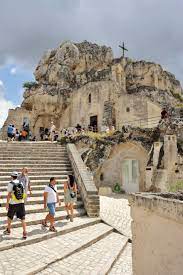Italy: How to spend a weekend in Matera, rock-hewn city

Doug Loynes
Rome: It’s a remarkable rags-to-riches story. Carved into a remote ravine in the Basilicata countryside, in the instep of Italy’s boot, Matera was once dubbed ‘the shame of Italy’ for its caves that housed the city’s poor and exploited rural workers; by the 1970s, it’d become a ghost town, the first time the settlement had been uninhabited in 10,000 years. Yet a decade later, its evocative beauty lay the foundations for an extraordinary revival, thanks to a group of enterprising local creatives (many descended from the original inhabitants) who spotted its potential.
These days, the city’s churches jostle for space with boutique hotels, galleries and restaurants that have themselves been repurposed from former cave dwellings. Matera now has UNESCO status, was Europe’s 2019 Capital of Culture and has even drawn the gaze of Hollywood via Mel Gibson’s The Passion of the Christ and the latest Bond film.
Still, Matera’s local traditions and resilient spirit have proved as durable as its stone foundations. Today, the city is surely one of the country’s most extraordinary and beguiling destinations.
Morning: Daniel Craig might have raced an Aston Martin through Matera’s cobbled alleyways, but a more productive way to explore the city is with a guided walking tour. While some are purpose-built for cinephiles, Martulli Viaggi offers one that focuses on the fascinating story of the fall and rise of Matera from an anthropological perspective — while still pointing out where the film scenes were shot. Tours wind through the two Sassi (stone) districts, Sasso Caveoso and Sasso Barisano — part of the old town where ancient excavations carved out of the soft limestone are now occupied by hotels, restaurants and museums. For a window into life before the sassi were abandoned, be sure to visit a casa grotta, a museum where the subterranean space has been faithfully modelled to replicate an original cave home.

Afternoon: As a former European Capital of Culture, Matera has no shortage of fine museums, and the Museum of Contemporary Sculpture is as good a starting point as any, with its spectacular setting and modern masterpieces. You’ll venture deep into a myriad of caverns; there’s a poetic symbolism in the housing of sculptures by contemporary artists like Arnaldo Pomodoro in an environment itself sculpted centuries ago. It’s then a five-minute walk to the Santa Maria de Idris, one of Matera’s 150 frescoed church caves. The church and its crypt’s medieval murals might have paled with time, but it’s still worth visiting for its winning location, lording over the Sassi to the west and the Murgia National Park to the east. Plus, Zipa cafe next door whips up some great cocktails, including z-panch (spiced rum, sweet sage and lemon liqueur).
Evening: The 17th-century ‘new’ town, which rests atop the sassi districts, is made for a leisurely evening stroll, with its alleyways spilling out onto piazzas fringed with pretty cafes and gelaterias. Dusk is when Matera’s magic really comes to life: the Sassi’s sandy hues begin to glow in soft pinks and oranges, while lamps twinkle like fairy lights. Nightfall transforms piazza Giovanni Pascoli from sleepy square into a dynamic hub. The place to be is Area 8, by day a co-working space for creatives and by night a cocktail bar with live music and the occasional cinema screening. For something more exclusive, head around the corner and dip your head into Sasso Caveoso for a dinner of Lucanian black pork and a glass of full-bodied red at the Radino Wine Bar, a celebration of Italy’s wine culture built within — you guessed it — a cave.
Day two: cooking & crypts. Morning: If wandering through Matera’s sassis is like travelling back to medieval times, then an amble in the Murgia Materana National Park on the other side of the canyon feels positively prehistoric. It’s a 10-minute drive or, if you’re feeling energetic, you can go on foot using the Belvedere Murgia Timone trailhead next to the car park on the eastern side of the Sassi. It’s a four-mile circular trail, which will see you cross the Gravina canyon by suspension bridge before clambering up 1,000-year-old paths to explore yawning natural caves inhabited since the Stone Age and rock-cut churches frescoed with seventh-century Byzantine art. The views are best at dawn — gaze westwards across the canyon as the sun rises behind you to witness Matera basking in an ethereal glow.
Afternoon: Nowhere does pasta quite like Italy, but the shapes and styles differ from region to region. Learn the secrets of the south with a pasta-making class at Le Dodici Lune, a cave hotel in Sasso Caveoso. You’ll handcraft your own cavatelli and strascinati pasta shells using only rimacinata flour and water before tossing them with turnip tops and garlic. Enjoy with a glass of wine in the hotel’s breezy courtyard. After lunch, you might not feel like you have much of an appetite for any more frescoed churches, but a tour of the Crypt of Original Sin is a must, and sure to take your breath away. Lauded as the Sistine Chapel of cave art, its depictions of biblical scenes and portraits are the best in the region, thanks to the painstaking restoration work that’s been done to preserve them for visitors.
Evening: Enjoy the spell-binding sunset from Piazza Duomo, where you’ll find the cathedral that crowns the city, then head for Via Domenico Ridola, a lively strip of bars and restaurants. Save room for dessert-to-go from I Vizi degli Angeli, a gelato ’laboratory’ that whips up the best sweet treats in the city. When you’re finished, head back to your hotel, which, for the full Matera experience, should be a renovated cave. At Le Grotte della Civita, the bedrooms — candle-lit and embellished with rustic wooden furnishings — combine medieval charm with modern comforts such as underfloor heating. Renovating and restoring the cave was a labour of love and took years as part of a cultural project to conserve the local heritage. The result is among the world’s most unique and unforgettable hotel stays.
Top three Matera museums. 1. Domenico Ridola Archaeological Museum: The collection of artefacts, donated by founder and archaeologist Domenico Ridola in 1911, traces the history of human settlement in Matera from the Paleolithic era to the Middle Ages via the Greek occupation. Exhibits include the fossilised ‘Julian whale’ and reproductions of Magna Graecia vases. It forms part of the National Museum of Matera, along with the Museum of Medieval and Modern Art in the splendid Palazzo Lanfranchi.
- Museum-Workshop of the Peasant Culture: Picking up where the Domenico Ridola leaves off, this museum’s exhibition rooms are reconstructions of craft workshops and homes from Matera’s more recent history. Visit a blacksmith, barber, cobbler and cabinet maker on a tour of peasant life before the evacuation. You can also see a typical cave house and public wine cellar, where peasants would have gathered to relax and chat.
- Matera Olive Oil Museum: Where else but Matera could you find a 500-year-old olive oil mill in a cave? A ticket gets you a 30-minute guided tour through the mill’s rooms, including the stable, which housed the donkeys used to turn the mill, as well as the room where the olives were deposited, which is now used for tastings.
Matera has brought a lot of attention to the lesser-visited southern region of Basilicata, but there are more historic towns and villages in the region that haven’t yet entered the limelight. Here are some of the best.
- Pietrapertosa: About an hour’s drive west of Matera, the village of Pietrapertosa clings to the jagged slopes of the Lucanian Dolomites. Some of the world’s most celebrated civilisations have left their mark here: the Greeks were first, followed by the Romans, then the Goths, before the Saracens carved a crowning fortress into the cliffside in the 10th century. At an altitude of over 3,000ft, Pietrapertosa is Basilicata’s loftiest town, a shade higher than its neighbour, Castelmezzano. This equally striking village can be reached from Pietrapertosa by the Path of the Seven Stones trail or by zip-line: Il Volo dell’Angelo (the Flight of the Angels) will whisk you between the two, superman-style, at speeds of up to 75mph.
- Maratea: Maratea is also known as the Pearl of the Tyrrhenian, and it’s not at all difficult to see why. Watched over by a 70ft statue of Christ from the summit of Monte San Biagio, Maratea is made up of a scattering of small communities nestled in the leafy coastal hillside. Just like Matera, you can expect to encounter centuries-old frescoes in the old town’s churches, but the caves here have a different character: the countless, sea-cut caverns that pock the coastline house magnificent stalactites and stalagmites. Maratea is also a perfect place to stop off on a road trip through southern Italy: the coastal road overlooking the Tyrrhenian Sea’s turquoise waters is on par with the famed Amalfi Drive — only without the traffic.
- Rotonda: There are enough crumbling churches and castle ruins in Rotonda to keep history buffs busy, but outdoor adventures are its main draw. This is one of the best jumping-off points to explore the Pollino National Park, which is among Italy’s largest protected wildernesses and sweeps over mountain ridges and river canyons from the Tyrrhenian Sea to the Ionian coast. The national park headquarters in Rotonda are a useful resource: book a certified guide through them or count on their extensive knowledge of the best hiking and mountain biking trails to plot your own course through the old-growth forests, where rare Bosnian pines grow
and Apennine wolves roam.
Top five cave restaurants. 1. Trattoria del Caveoso: For portions of pasta piled high, make a beeline for Trattoria del Caveoso. Traditional dishes made with local produce are the name of the game here: expect regional cheeses and cold cuts to start, followed by fresh cavatelli with crispy crusco peppers or turnip greens.
- Vitantonio Lombardo Ristorante: Basilicata-born chef Vitantonio Lombardo’s restaurant brought the very first Michelin star to Matera with a menu that draws lovingly on the city’s story — think pasta in traditional legume soup. Opt for the pancia tasting menu with wine pairing for a culinary tour-de-force.
- Regiacorte: The youthful team behind this upmarket restaurant in the Sassi aren’t afraid to go bold with offerings like octopus parmigiana and sweet cinnamon ricotta as a main. Dishes are as much a feast for the eyes as for the belly.
- La Lopa: Sheep stew and black pork cheek are some of the classic local dishes served at little La Lopa, but you shouldn’t overlook the offerings from the vegetable garden, too. Don’t be put off by the crapiata’s name — it’s a delicious mixed vegetable soup.
- Crialoss: Scenic dinner spots in Matera aren’t as common as you’d think — grand residences in the 17th-century new town were typically built to face the piazzas, literally turning their back on the Sassis below — which makes the panoramic views from this bistro’s terrace even more special. Expect to see ricotta puff pastries and sharing platters of cured meats.
How to do it: The nearest airport to Matera is Bari. Ryanair flies from Stansted and Wizz Air from Gatwick, with a flight time of around three hours.
From Bari, European travel operator Omio runs a regular bus service to Matera, which takes just over an hour. Prices start at €3 (£2.65) each way. The Sextantio le Grotte della Civita has doubles from €250 (£220), B&B.





